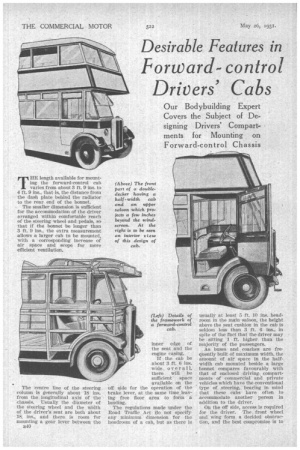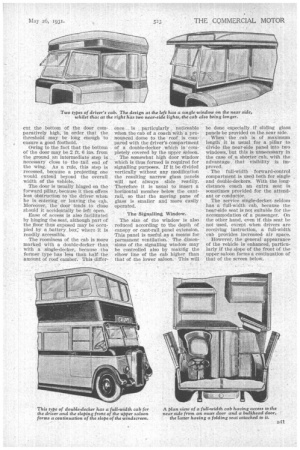Desirable Features in
Page 58

Page 59

If you've noticed an error in this article please click here to report it so we can fix it.
Forwardcontrol Drivers' Cabs
Our Bodybuilding Expert Covers the Subject of Designing Drivers' Compartments for Mounting on Forward-control Chassis
THE length available for mounting the forward-control cab varies from about 3 ft. 9 ins. to 4 ft. 9 ins., that is, the distance from the dash plate behind the radiator to the rear end of the bonnet.
The smaller dimension is sufficient for the accommodation of the driver arranged within comfortable reach of the steering wheel and pedals, so that if the bonnet be longer than 3 ft:9 ins., the extra measurement allows a larger Cab to be mounted, with a corresponding increase of air space and scope for more efficient ventilation.
centre line of the steering column is generally about 18 ins. from the longitudinal axis of the chassis. Usually the diameter of the steering wheel and the width of the driver's seat are both'about 18, ins., and there is room for mounting a gear lever between the
340 The inner edge of the seat and the engine Casing..
If: the cab be about 3 ft. 6 ins. wide.. overall, there will be
sufficient, space available on the off side for the operation of the brake lever, at the same time leaving free floor area to form a landing.
The regulations made under the Road Traffic Act o not specify any minimumdimension for the headroom of a cab, but as there is usually at least 5 ft. 10 ins, headroom in the main saloon, the height above the seat cushion in the cab is seldom less than 3 ft. 6 ins., in spite of the fact that the driver may be sitting 1 ft. higher than the majority of the passengers.
As buses and . coaches are fre. quently built of maximum width, the amount of air space in the halfwidth cab mounted beside a large bonnet compares favourably With that of enclosed driving compartments of commercial and private vehicles which have the conventional type of steering, bearing in mind that these cabs have often to accommodate another person in addition to the driver: On the off side, access is required for the driver, The, front wheel and wing form a decided obstruction, and the best compromise is to cut the bottom of the door comparatively high, in order that the threshold may be long enough to „ ensure a good foothold.
Owing to the fact that the bottom of the door may be 2 ft. 6 ins, from the ground. an intermediate step is necessary close to the tail end of the wing. As a rule, this step is recessed, because a projecting one would extend beyond the overall width of the vehicle.
The -door is 'usually hinged on the forward pillar,-because it then offers less obstruction to the driver when he is entering. or leaving the cab. Moreover, The door tends to close should it accidentally be left open.
Ease of access is also facilitated by hinging the seat, although part of
• the ,fioor thus exposed may be occupied .by a ,battery box-, where it is
readily. accessible. : • The roominess of the cab is more marked with a double-decker than • with a single-decker, because • the former type has less than half the amount of roof camber. Plus differ_ etwe particularly noticeable When the cab of a coach with a pronounced dome to the roof, is compared with the driver's compartment of a' double-decker which is completely covered by the upper saloon. The somewhat high door window which is thus formed is required for signalling purposes. If it be divided vertically without any modification the resulting narrow glass panels will not always slide, readily. Therefore it is usual to insert a horizontal member below the cantrail, SC) that • the moving pane of glass is smaller and more easily operated.
The Signalling Window.
The size of the window is also reduced according to the depth of canopy or• cant-rail panel extension. This panel is useful as a means for permanent ventilation.: The dimensions of the signalling window may be controlled also by making the elbow' line of the cab higher than that of the lower saloon. This will
be done. especially if sliding glass panels be provided on thP near side.
When the cab is of maximum length. it Is usual for a pillar to divide the near-side panel into two windows, but this is Unnecessary in the case of ..-a shorter cab, with the advantage that visibility is improved.
The full-width forward-control compartment is used both for single and double-deckers. With the longdistance coach an extra seat is sometimes provided for the attendant or conductor.
The service single-decker• seldom has a full-width cab, because the near-side seat is riot suitable for the accommodation of a passenger. On the other hand, even if this seat be not used, except when drivers are receiving instruction, a full-width cab provides increased air space.
However, the general appearance of the vehicle is enhanced,' particularly if the slope of the front of the upper salonn forms a continuation of that of the screen below.




































































































